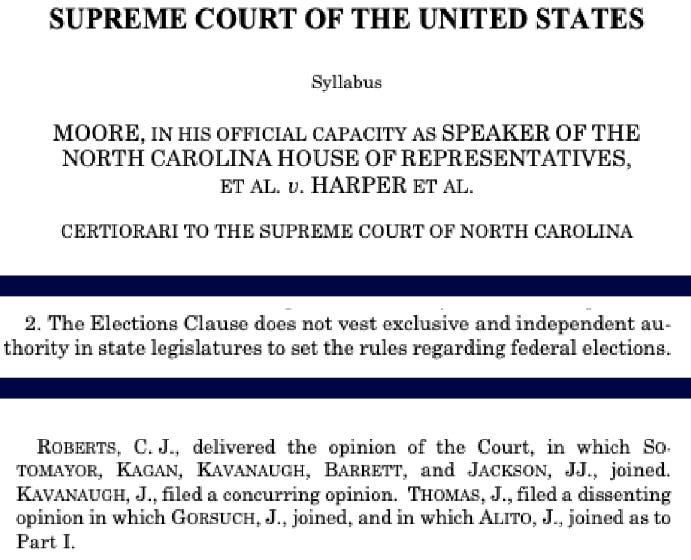The US won Moore v. Harper. Supreme Court decides Moore v. Harper, holding that the case is not moot and REJECTING the independent state legislature theory. Court is really vague about what state courts can do in interpreting state constitutional provisions. We'll see more litigation in the future. This was a temporary reprieve. Republicans will still continue fighting to invalidate free and fair elections.
In a 6-3 decision authored by Chief Justice Roberts, the Supreme Court in Moore v. Harper powerfully rejected the independent state legislature theory. We must not forget that this case was completely insane. A normal Supreme Court would have laughed at this and ruled 9-0 instead of 6-3. The Supreme Court's long-awaited decision in Moore v. Harper is a resounding, reverberating victory for American Democracy. The Court meticulously reasoned through its decision exactly.
Only Justices Thomas, Alito, and Gorsuch dissent. And Alito only dissents on the grounds that the court should have dismissed the case. Kavanaugh and Barrett join Roberts' opinion in full. This is a rout for proponents of the independent state legislature theory.
Wonder if public shaming of SCOTUS (thanks investigation from ProPublica) for the court's apparent capture by right-wing billionaires, might have played a role in this Moore v. Harper decision, which could hardly be more significant in the fight to protect American democracy. It's difficult to overstate how big of a win this is for democracy. The Moore decision ensures that state courts can continue to review election laws enacted by state legislatures under state constitutions and maintains an important check on GOP voter suppression policies.
The Court adopted the arguments made by my client Common Cause in every material respect. Following the Court’s decision, it is clear that state legislatures must comply with state constitutions when engaged in congressional redistricting. State courts may exercise judicial review to ensure that state legislatures do not violate state constitutional provisions. And federal courts in turn may review state court decisions to ensure they do not circumvent federal constitutional requirements.
People, including people on our side of the v., didn’t believe we could win. They wanted to try to get rid of the case. Those arguments were wrong, and misguided, and stand as a powerful lesson that through careful study of the US Supreme Court’s decisions, litigants can win cases that stand up for US democracy.
Chief Justice Roberts' opinion for the court holds that state legislatures do NOT have plenary authority over election law, and that federal courts do NOT have freestanding authority to strike down election laws that ostensibly conflict with the state legislature's preferences. The decision in Moore is a huge victory for democracy, ensuring that state courts can continue to review election laws enacted by state legislatures under state constitutions, and that federal courts do not have freewheeling power to meddle in state election schemes.
The death of independent state legislature theory is a major win for democracy. It was one of the easiest and clearest paths to outright fascism and could have allowed legislatures to overturn courts and election results.
It is indeed a cause for celebration that the United States Supreme Court, on a 6-3 vote in Moore v. Harper, rejected an extreme version of the “independent state legislature” theory that could have upended the conduct of elections around the country and paved the way for state legislatures to engage in election subversion. But after the celebration comes the inevitable hangover, and with all the hoopla it is easy to miss that the Supreme Court has now set itself up, with the assent of the liberal justices, to meddle in future elections, perhaps even deciding the outcome of future presidential elections (as it has done in the past). Chief Justice John Roberts drove a hard bargain.
The facts and law are complex, but here’s the basics. The North Carolina general assembly—the state’s legislature—is controlled by Republicans and drew its congressional districts to maximize the number of Republican seats. The state supreme court, then controlled by Democrats, held that the partisan gerrymander by the General Assembly violated that part of the state constitution that guaranteed North Carolina voters the right to free and fair elections. The legislators then went to the U.S. Supreme Court, arguing that the state court ruling violated the U.S. Constitution, in particular the part of the Constitution that gives state legislatures the power to decide the rules for conducting congressional elections. (There’s a similar provision involving the power of legislatures to decide the rules for conducting presidential elections.)
The legislators advanced an extreme theory, which thankfully Chief Justice Roberts rejected in his opinion for the court, joined by conservative justices Amy Coney Barrett and Brett Kavanaugh, along with the three liberal Justices. The extreme theory was that state legislatures can pass whatever election rules they want for federal elections, and state courts could not constrain them even when they violated their own state constitutions. The court made clear that legislatures do not have this free floating power, and that one must understand the legislature’s power within the ordinary system of state government, including judicial review. Even more, the Court reaffirmed a 2015 ruling that was decided just 5-4 before three of the newer conservative justices joined (in which the chief justice had dissented) confirming that states do not violate this theory when they use voter initiatives to create independent redistricting commissions to draw congressional lines. That’s another reason for celebration.
Justice Clarence Thomas, joined by Justice Neil Gorsuch, two of the most conservative members of the court, dissented and embraced a version of this extreme theory. (Justice Samuel Alito also joined part of Thomas’ dissent that argued the case should be dismissed on mootness grounds, as the partisan makeup of the North Carolina Supreme Court has since changed hands and the new court has since rejected the findings of the earlier one.) Had this dissent carried the day, it would have provided a path for state legislatures to engage in all kinds of chicanery and, as I argued in a brief I filed with the court, it would turned every state judicial and administrative decision involving elections into a federal case. That would have added confusion and gamesmanship all around.
But Moore is not all good news. In the last part of his majority opinion for the court, the chief justice got the liberal justices to sign onto a version of judicial review that is going to give the federal courts, and especially the Supreme Court itself, the last word in election disputes. The court held that “state courts may not transgress the ordinary bounds of judicial review such that they arrogate to themselves the power vested in state legislatures to regulate federal elections.”
To understand these dense words, we need to go back to the last time the Supreme Court decided a major election case, the 2000 Bush v. Gore decision (a case cited in Moore for the first time ever in a majority opinion in the 23 years since that decision). In Bush, the Florida Supreme Court had ordered a recount of only certain ballots in Florida to determine if Democrat Al Gore or Republican George W. Bush had won the state’s electoral college votes and therefore the presidency. At the time, Bush was ahead by only hundreds of votes out of millions cast.
After the Florida court ordered the recount, Bush appealed to the U.S. Supreme Court. A majority held that the recount ordered by the Florida court violated the Equal Protection Clause because there was no guarantee that uniform standards were used or could be used to conduct it. But three justices—Chief Justice William Rehnquist, joined by Justices Antonin Scalia and Thomas—adopted this milder version of the independent state legislature theory at the time. In essence they argued that the Florida court’s interpretation of the Florida election statutes to allow this recount was so far from ordinary statutory interpretation that the Florida court was essentially making up the law for itself, and taking away the legislature’s power to decide the rules for conducting federal elections in the first instance.
It is this milder version of the independent state legislature theory that the court embraced in Moore. It did not spell out its contours, and whether to adopt the Rehnquist Bush approach or some other approach. But Justice Kavanaugh, in a concurrence, endorsed the Rehnquist approach and said that in engaging in this second guessing, federal courts need to compare election law in the state in earlier decisions. The greater the deviation, the more likely to find a violation of the independent state legislature theory.
Make no mistake: this apparent new test would give great power to federal courts, and especially to the U.S. Supreme Court, to second guess state court rulings in the most sensitive of cases. It is going to allow for a second bite at the apple potentially in cases involving the outcome of presidential elections. In the 2020 presidential election, for example, Trump allies raised this theory in arguing that Pennsylvania’s Supreme Court could not extend the days for the receipt of absentee ballots by three days in light of the pandemic. There were not enough of these late arriving ballots to make a difference in 2020, but if there had been, according to the approach laid out in Kavanaugh’s concurrence, the U.S. Supreme Court would have had to look at Pennsylvania court precedents to decide if the state court went too far in deciding matters under its own state laws. It easily could have decided the outcome of the election based on its view of this question.
It fell to Justice Thomas, who ironically joined Rehnquist’s Bush concurrence, to point out how much discretion Roberts’ test—vaguer than the one laid out by Kavanaugh—leaves to the whims of federal judges: “What are ‘the bounds of ordinary judicial review’? What methods of constitutional interpretation do they allow? Do those methods vary from State to State? And what about stare decisis—are federal courts to review state courts’ treatment of their own precedents for some sort of abuse of discretion? The majority’s framework would seem to require answers to all of these questions and more.”
In the end, the liberals had to swallow a bitter pill without a word presumably to keep a majority with the conservative justices and reject the most extreme version of the theory. The writing was on the wall at oral argument, when attorneys defending voting rights in North Carolina had to concede there was to be some judicial review when a state supreme court goes completely nuts in purportedly applying election laws.
But what Roberts left unresolved in his majority opinion is going to be hanging out there, a new tool to be used to rein in especially voter-protective rulings of state courts. Every expansion of voting rights in the context of federal litigation will now yield a potential second federal lawsuit with uncertain results.
It’s going to be ugly, and it could lead to another Supreme Court intervention in a presidential election sooner rather than later. Moore gave voters a win today, but it sets up a Supreme Court power grab down the line.
“And when you talk of democracy, if there are no human values and there is no humanity, there are no human rights, then it’s not a democracy.”
==========END————
Thank you, as always, for reading. If you have anything like a spark file, or master thought list (spark file sounds so much cooler), let me know how you use it in the comments below.
If you enjoyed this post, please share it.
If a friend sent this to you, you could subscribe here 👇. All content is free, and paid subscriptions are voluntary.
————
-prada- (Adi Mulia Pradana) is a Helper. Former adviser (President Indonesia) Jokowi for mapping 2-times election. I used to get paid to catch all these blunders—now I do it for free. Trying to work out what's going on, what happens next. Arch enemies of the tobacco industry, (still) survive after getting doxed.
(Very rare compliment and initiative pledge. Thank you. Yes, even a lot of people associated me PRAVDA, not part of MIUCCIA PRADA. I’m literally asshole on debate, since in college). Especially tonight heated between Putin and Prigozhin.
========
Thanks for reading Prada’s Newsletter. I was lured, inspired by someone writer, his post in LinkedIn months ago, “Currently after a routine daily writing newsletter in the last 10 years, my subscriber reaches 100,000. Maybe one of my subscribers is your boss.” After I get followed / subscribed by (literally) prominent AI and prominent Chief Product and Technology of mammoth global media (both: Sir, thank you so much), I try crafting more / better writing.
To get the ones who really appreciate your writing, and now prominent people appreciate my writing, priceless feeling. Prada ungated/no paywall every notes-but thank you for anyone open initiative pledge to me.
(Promoting to more engage in Substack) Seamless to listen to your favorite podcasts on Substack. You can buy a better headset to listen to a podcast here (GST DE352306207). Listeners on Apple Podcasts, Spotify, Overcast, or Pocket Casts simultaneously. podcasting can transform more of a conversation. Invite listeners to weigh in on episodes directly with you and with each other through discussion threads. At Substack, the process is to build with writers. Podcasts are an amazing feature of the Substack. I wish it had a feature to read the words we have written down without us having to do the speaking. Thanks for reading Prada’s Newsletter.









